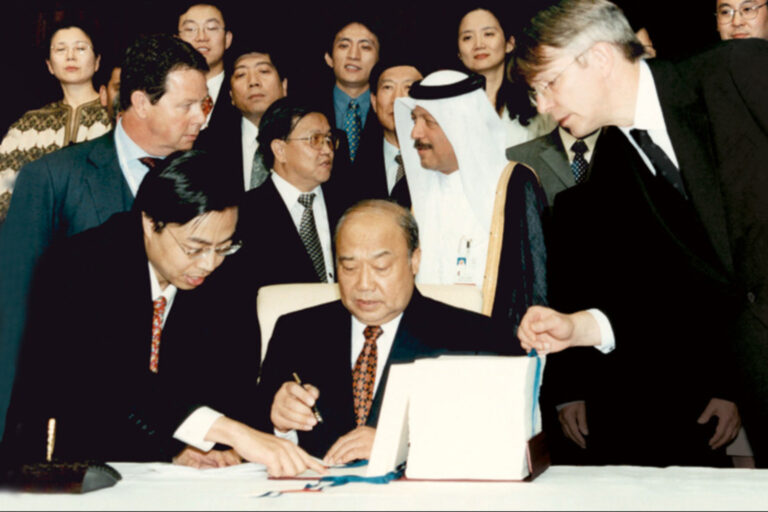Photo Credit: Deeba Yavrom
Note: The following piece is part of the SAIS Review‘s first web series on the topic of Sustainable Development and the Millennium Development Goals. For more information, please refer to the Sustainable Development web series page.
By Jeongsu Sinn
GOAL: Strengthen the global partnership to increase and improve the flow of technology, financial resources, and information so that actors and sectors working to achieve sustainable development can take a more universal and integrated approach and so that other SDGs can be achieved through producing tangible outcomes.
TARGETS:
- Technology target: Increase the transfer and use of climate adaptation technologies related to water, food, and health in order to halve extreme poverty from 2015 levels by 2030
- Financial resource target: Increase and leverage public-private partnerships (PPPs) in green infrastructure in emerging economics by x percent by 2030, first starting with North-South PPPs and expanding to more South-South PPPs
- Information target: Incorporate better quantitative and qualitative data in reporting and assessment mechanisms to increase transparency
Summary
Goal 8 of the Millennium Development Goals (MDGs) was to “Develop a global partnership for development,” through targets such as developing a more “open, rule-based, predictable, non-discriminatory” trading and financial system; addressing the special needs of least developed countries (LDCs), landlocked developing countries, and small islands developing states (SIDS); and partnering with the private sector to make available to the developing world the benefits of new technologies, particularly those of information and communications.[1] The goal proposed in this paper is to strengthen and broaden the global partnership for development (MDG 8), particularly aiming at implementing targets related to increasing and improving the flow of technology, financial resources, and information. Coordination of these three factors is crucial in interactions and cooperation among developed and developing countries, the public and private sector, and other actors. It is also vital to enhancing the integration of different pillars and sectors related to sustainable development. Strengthening the global partnership will allow for a more universal and integrated approach that will allow future Sustainable Development Goals (SDGs) to be met by increasing the effectiveness and efficiency of projects and also by producing tangible results by 2030.
Background
The goal of strengthening a global partnership attempts to tackle existing and emerging problems that will challenge the fulfillment of the SDGs and that will threaten the ability of countries and their people to develop sustainably. The following deficiencies need to be addressed in order to build on the achievements of the MDGs and achieve the more ambitious SDGs.
- The universality problem
The MDGs have been criticized for not equally engaging developed and developing countries in the goals, resulting in different perceptions among countries of the benefits and responsibilities of meeting the goals. The earth’s carrying capacity will be further challenged by the continued growth of emerging economies. It is expected that they will account for 70 percent of world economic growth up until 2030.[2] Their participation in sustainable development will greatly affect the universality of the SDGs.
- Lack of integration amongst the three pillars of sustainable development
The economic, environmental, and social pillars were not given equal emphasis in the MDGs. Additionally, although countries like South Korea and Mexico along with international organizations have been leading a transformation towards development where economic growth and improved environmental and social conditions are improved simultaneously, no country has yet achieved these development goals in the past two decades.
- Insufficient flow of technology, financial resources, and information
Lastly, the flow of technology, financial resources, and information has been insufficient compared to the level needed to implement sustainable development projects. There exists a huge gap between the availability and necessity of technology and the financial resources for environmentally sound technologies. Also, lack of information and transparency are key constraints to channeling funds and investments into SDG projects.
Opportunity
Improving the quantity and the quality of the flow of technology, financial resources, and information will enhance global partnership in two ways. First, the insufficiency of the three factors has been the main reason for low participation of different stakeholders; thus, increasing the flow of these factors will ensure the participation and involvement of developed and developing countries, diverse actors, and different pillars and sectors. Second, it will also improve the quality of interaction and cooperation amongst different actors and sectors, remove the barriers to cooperation as well as boost confidence in them, and contribute to improving the overall outcome of the SDGs. In short, increased and enhanced flows of the three factors will strengthen the fundamental core of sustainable development, which is a universal approach to our common future, and also ensures the integration of the three pillars. More specific opportunities in each of the flows include:
- Climate Adaptation Technologies
Transferring climate adaptation technologies is crucial to tackling poverty. Climate change will affect least developed countries (LDCs) and extremely vulnerable societies as extreme weather events become more frequent and as resources become even more scarce. The IPCC mentioned in their report that the frequency of extreme weather events such as heat waves has been gradually increasing since the 1980s.[3] Also, based on data collected since the 1950s, the IPCC predicts that the overall frequency, intensity, and length of these events will increase even more.[4] Failing to strengthen resilience to climate change may reverse the achievements of the MDGs.
- Finance Opportunity
Much of the growth in emerging economies will involve the construction of new infrastructure. Developing countries spend approximately $1 trillion on infrastructure every year and an additional investment of $1.5 trillion is required to meet demands in these countries through 2020.[5] It is thus crucial to ensure that financial resources will fund green infrastructure because they can last for years to come. More public-private partnerships (PPPs) in green infrastructure projects in emerging economies can contribute to their sustainable development and can create opportunities for the public and private sector cooperation.
- Information Technology
The data revolution and the use of big data can be used to increase the availability of information, the quality of information, and information management to enhance transparency in the assessment and monitoring of SDG projects. This will raise awareness of the SDGs and give more confidence to participating countries and key stakeholders.
Goal and Targets
Goal
Strengthen the global partnership to increase and improve the flow of technology, financial resources, and information so that actors and sectors working to achieve sustainable development can take a more universal and integrated approach and so that other SDGs can be achieved through producing tangible outcomes.
Targets
The targets should not only help reach the overall goal of increasing access to these three factors, but they should also help improve the broader prospects for sustainable development. Technology, financial resources, and information should flow to areas that need them the most and also to places that severely lack them due to governments or societies deficient in certain capabilities. Targets that will enhance access to technology, resources, and information include:
- Technology target: Increase the transfer and use of climate adaptation technologies related to water, food, and health in order to halve extreme poverty from 2015 levels by 2030
Technology can play a major role in meeting the realistic target of reaching 9.7 percent of extreme poverty by 2030—approximately half of that of 2015.[6] Technology is key to addressing poverty issues in areas where societies will become even more vulnerable as climate change proceeds. Food, water, and health security are essential to combating poverty and to introducing climate adaptation technologies that will help societies adapt in a way that will increase their resilience while minimizing stress on the local ecosystem’s carrying capacity. These technologies will include—but will not be limited to—the following low-cost and readily available technologies: small water reservoirs and micro-catchment water technologies, adoption of less water intensive crops in areas where precipitation levels are estimated to fall, and mosquito nets to prevent Malaria infection.
Indicators: Indicators related to measuring the volume of the flow of technologies, and its impact on tackling poverty need to be included and should be measured nationally and locally. Possible indicators include:
- Percentage of adaptation technologies related to food, water, and health identified by the Technology Facilitation Mechanism that have been adopted in LDCs
- Gross domestic expenditure on the transfer of climate adaptation technologies as share of GDP
- Purchasing power, GNI, and poverty level indicators
Potential lead agency: Technology Facilitation Mechanism
- Financial resource target: Increase and leverage public-private partnerships (PPPs) in green infrastructure in emerging economics by x percent by 2030, first starting with North-South PPPs and expanding to more South-South PPPs
Ensuring the sustainable development of emerging economies is crucial because these economies are where most of the world’s economic development will take place. Putting in place green infrastructure will influence energy consumption and resource use, which will affect the environment and economic growth of societies that have access to it. Unfortunately, however, there exists a gap between investments needs and actual spending. According to the World Economic Forum (WEF), this gap is about $1 trillion per annum.[7] Additional financing will be possible with the involvement of the private sector and thus, PPPs will be crucial. Also, to increase the involvement of developing countries in sustainable development, more South-South PPPs will be critical in the long run.
Indicators: The quantity and quality of PPPs in green infrastructure in emerging economies should be measured. Possible indicators include:
- Total number of PPPs in green infrastructure projects
- Percent of PPP in green infrastructure
- Number of North-South PPPs
- Number of South-South PPPs
- Number and utilization of public-private dialogue (PPD) and private sector representativeness
Potential lead agencies: World Bank; national and local PPP agencies
- Information target: Incorporate better quantitative and qualitative data in reporting and assessment mechanisms to increase transparency
Data is key to identifying inefficiencies by identifying what needs to be improved or leveraged to achieve sustainable development, meet specific targets, and guarantee the success of sustainable development projects and initiatives. Increasing the use of data will enhance accuracy and effectiveness because it will help monitor the process and progress of projects and will also help measure their outcomes. In addition, actors—especially the donor countries, the private sector, and investors—will gain more confidence since transparency will be improved with the availability of more information and data. This will likely lead to increased willingness to be involved and will, in turn, lead to more investment in sustainable development projects. Also, more unconventional data, which may include surveys and qualitative data, can improve the quality of information available. Big data management can be used to better manage new data and cooperation amongst already existing big data platforms will help efficient use of data that is already being collected and managed.
Indicators: Indicators should help measure the quantity of data and its widespread usage, as well as the quality, management, and use of data. Possible indicators include:
- Percent of nontraditional data
- Number of nontraditional sources
- Number of LDS and developing countries initiating open data
- Data sharing between different initiatives
Potential lead agency: UN Statistical Division
Table 1: Summary of the goal, targets and indicators
| Goal: Strengthen the global partnership to increase and improve the flow oftechnology, financial resources, and information | ||
| Technology Target:Increase the transfer and use of climate adaptation technologies related to water, food and health in order to halve extreme poverty from 2015 levels by 2030 | Financial Resources Target:Increase and leverage North –South and South-South PPPS in green infrastructure in emerging economics by x% by 2030 | Information Target:Incorporate better quantitative and qualitative data in reporting and assessment mechanisms to increase transparency |
| Indicators:- % of adaptation technologies identified by the Technology Facilitation Mechanism that have been made available
– Gross domestic expenditure on the transfer of climate adaptation technologies as share of GDP – Purchasing power, GNI and poverty level indicators |
Indicators:- Total number of PPPs in green infrastructure projects
– % of PPP in green infrastructure – Number of North-South PPPs – Number of South-South PPPs – Number and utilization of PPD and private sector representativeness |
Indicators:- % of nontraditional data
– Number of nontraditional sources – Number of LDS and developing countries initiating open data – Data sharing between different initiatives |
Jeongsu Sinn is an MA candidate at the Johns Hopkins Paul H. Nitze School of Advanced International Studies.
Citations
[1] United Nations, “Goal 8: Develop a Global Partnership for Development,” Millennium Development Goals, http://www.un.org/millenniumgoals/global.shtml.
[2] Standard Chartered, “The Super-Cycle Lives On: Emerging markets growth is key,” Special Report, (2013), https://www.sc.com/en/resources/global-en/pdf/Research/The-super-cycle-lives-06-11-13.pdf.
[3] IPCC, “Managing the Risks of Extreme Events and Disasters to Advance Climate Change Adaptation,” Special Report of the Intergovernmental Panel on Climate Change, (2012).
[4] IPCC, “Managing the Risks of Extreme Events and Disasters.”
[5] “Global Infrastructure Facility,” World Bank, www.worldbank.org/en/topic/publicprivatepartnerships/brief/global-infrasturcture-facility.
[6] Laurence Chandy, Natasha Ledlie and Veronika Penciakova, “The Final Countdown: Prospects for Ending Extreme Poverty by 2030,” Brookings Policy Paper, April 2013.
[7] WEF, “Strategic Infrastructure,” World Economic Forum, 2012, http://www3.weforum.org/docs/WEF_IU_StrategicInfrastructure_Report_2012.pdf.



